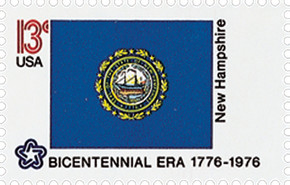
U.S. 1636
1976 Georgia State Flag
State Flags
American Bicentennial Series
• First time a sheet 50 had all different stamp designs
• Part of the American Bicentennial Series
Stamp Category: Commemorative
Series: American Bicentennial Series
Value: 13¢ First-class postage rate
First Day of Issue: February 23, 1976
First Day City(s): Washington, DC
Quantity Issued: 8,720,100 (panes of 50)
Printed by: Bureau of Engraving and Printing
Printing Method: Photogravure
Format: Sheet of 50
Perforations: 11
Why the stamp was issued:
The United States Postal Service celebrated the American Bicentennial with a full pane of the Union’s fifty state flags.
About the stamp design:
One of Georgia’s first flags was the secession flag of 1860, picturing a coiled snake and the words “Our Motto, Southern Rights, Equality of the States, Don’t Tread on Me.” For the next 143 years, the various Georgia state flags were surrounded in controversy. Some of these designs incorporated the Confederate flag, which many residents found offensive.
In 2003, after countless flags and years of discussion, newly elected Governor Sonny Perdue resolved to put an end to the dispute. The new flag consisted of the “stars and bars” from the first flag of the Confederate States of America, with the Georgia State Seal in the blue canton.
About the printing process:
Printed by the Bureau of Engraving and Printing on their seven-color Andreotti gravure press (601) which was their work horse for multicolored stamps.
About the American Bicentennial Series:
In the 1970s, America celebrated its 200th anniversary with hundreds of national events commemorating the heroes and historic events that led to our nation’s independence from Great Britain. The U.S. Postal Service issued 113 commemorative stamps over a six-year period in honor of the U.S. bicentennial, beginning with the American Revolution Bicentennial Commission Emblem stamp (U.S. #1432). As a group, the Bicentennial Series chronicles one of our nation’s most important chapters, and remembers the events and patriots who made the U.S. a world model for liberty.
Several of the stamps honored colonial life – craftsmen and communication. Other stamps honored important battles including Lexington and Concord, Bunker Hill, and Saratoga. Significant events such as the Boston Tea Party, the meeting of the First Continental Congress, and the Declaration of Independence were featured as well. The stamps also honored many significant people such as George Washington, Sybil Ludington, Salem Poor, and the Marquis de Lafayette.
Many of the stamps feature classic artwork. For instance, the set of four souvenir sheets picture important events recreated by noted artists such as John Trumbull. The Bicentennial Series also includes an important US postal first – the first 50-stamp se-tenant – featuring all 50 state flags. The format proved to be popular with collectors, and has been repeated many times since.
The American Bicentennial Series is packed with important US history – it tells the story of our nation’s fight for independence through stamps.
History the stamp represents:
On January 2, 1788, Georgia was the fourth state to ratify the US Constitution, making it our fourth state.
The first human inhabitants of Georgia were the Mound Builders, a prehistoric Native American tribe. Over time, the Creek tribe settled in the South and the Cherokee in the North.
The first European to explore was probably Hernando de Soto of Spain. He crossed the region on a trip from Florida to the Mississippi River in 1540. Spain, France, and England all claimed the southeastern portion of North America as part of their territory, but it was a group of Englishmen who planned the first colony there in 1730. They named it Georgia, in honor of King George II.
King George made Georgia a royal province in 1754. Despite its prosperity, Georgia became involved in the movement for independence that was flourishing in other colonies. In 1775, when the Revolutionary War broke out in Massachusetts, support for independence solidified, and Georgia’s patriots seized power. Georgian forces first fought British troops in March 1776, when a British warship attempted to seize 11 rice boats in Savannah. Only two of the ships were captured. On July 24, 1778, Georgia ratified the Articles of Confederation.
On January 2, 1788, Georgia became the fourth state in the Union to ratify the United States Constitution.















